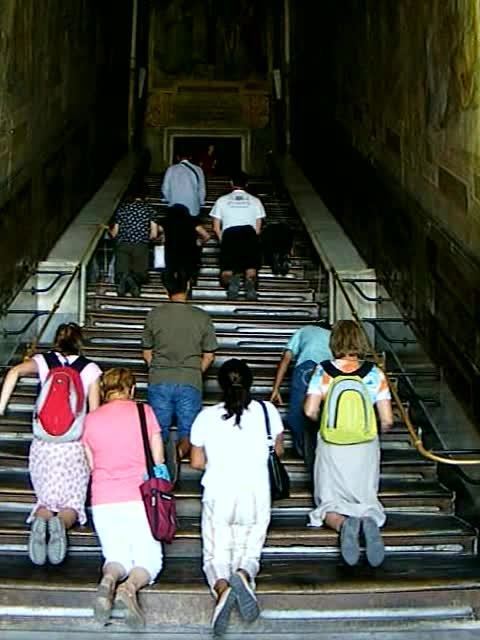Phone +39 06 772 6641 | ||
 | ||
Similar Archbasilica of St John Lateran, Sancta Sanctorum, Lateran, Lateran Palace, Basilica of Saint Paul Outside t | ||
La scala sancta pilgrims climb the steps on their hands and knees
The Scala Sancta (English: Holy Stairs, Italian: Scala Santa) are a set of 28 white marble steps that are Roman Catholic relics located in an edifice on extraterritorial property of the Holy See in Rome, Italy proximate to the Archbasilica of St. John in Laterano. Officially, the edifice is titled the Pontifical Sanctuary of the Holy Stairs (Pontificio Santuario della Scala Santa). The Holy Stairs, which long ago were encased in a protective framework of wooden steps, are in an edifice that incorporates part of the old, Papal Lateran Palace. The Holy Stairs lead to the Church of St. Lawrence in Palatio ad Sancta Sanctorum (Chiesa di San Lorenzo in Palatio ad Sancta Sanctorum) or simply the "Sancta Sanctorum" (English: Holy of Holies), which was the personal chapel of the early Popes.
Contents
- La scala sancta pilgrims climb the steps on their hands and knees
- Scala santa scala sancta holy steps rome
- History
- Decoration
- Scala Sancta in the Catholic Church
- Visitors
- Copies of the Scala Sancta
- References
According to Roman Catholic tradition, the Holy Stairs are the steps leading up to the praetorium of Pontius Pilate in Jerusalem on which Jesus Christ stepped on his way to trial during his Passion. The Stairs reputedly were brought to Rome by St. Helena in the fourth century. For centuries, the Scala Sancta has attracted Christian pilgrims who wish to honor the Passion of Jesus Christ.
Scala santa scala sancta holy steps rome
History
Medieval legends claim that St. Helena, mother of Emperor Constantine the Great, brought the Holy Stairs from Jerusalem to Rome circa AD 326. In the Middle Ages, they were known as "Scala Pilati" ("Stairs of Pilate"). From old plans it appears that they led to a corridor of the Lateran Palace, near the Chapel of St. Sylvester, and were covered with a special roof. In 1589, Pope Sixtus V had the Papal Lateran Palace, then in ruins, demolished to make way for the construction of a new one. He ordered the Holy Stairs be reconstructed in their present location, before the Sancta Sanctorum (Holy of Holies), named for the many precious relics preserved there, including the celebrated icon of Santissimi Salvatore Acheiropoieton ("not made by human hands") which on certain occasions used to be carried through Rome in procession. These holy treasures, which since Leo X (1513–21) had not been seen by anybody, have been the object of dissertations by Grisar and Lauer.
Decoration
The Scala Sancta are encased in protective wood and may only be ascended on the knees. For common use, the staircase is flanked by four additional staircases, two on each side, constructed circa 1589. Climbing the Holy Stairs on one's knees is a devotion much in favor with pilgrims and the faithful. Several popes have performed the devotion. As part of the ceremonies opening the Holy Year in 1933, Cardinal Francesco Marchetti Selvaggiani, Vicar of Rome, led a crowd of hundreds in mounting the steps on their knees.
The decoration of the Scala Santa was one of the major renovations of the pontificate of Pope Sixtus V, led by Cesare Nebbia and Giovanni Guerra and occupying a crew of artists to decorate frescoes including Giovanni Baglione, Giacomo Stella, Giovanni Battista Pozzo, Paris Nogari, Prospero Orsi, Ferraù Fenzoni, Paul Bril, Paulo Guidotti, Giovanni Battista Ricci, Cesare Torelli, Antonio Vivarini, Andrea Lilio, Cesare and Vincenzo Conti, Baldassare Croce, Ventura Salimbeni, and Antonio Scalvati. Numerous preliminary drawings by Nebbia for these frescoes are extant, though it is not known with certainty who painted each fresco.
A major restoration was completed in 2007 and funded largely by the Getty Foundation.
Scala Sancta in the Catholic Church
In the Roman Catholic Church, a plenary indulgence has been conceded for climbing the stairs on the knees. Pope Pius VII on 2 September 1817 granted those who ascend the Stairs in the prescribed manner an indulgence of nine years for every step. Finally, Pope St. Pius X, on 26 February 1908, conceded a plenary indulgence as often as the Stairs are devoutly ascended after Confession and Holy Communion.
Visitors
Martin Luther allegedly climbed these steps on his knees in 1512. As he did so, he repeated the Pater Noster. "Luther was one day devoutly climbing these steps, when suddenly a voice like thunder seemed to say to him: The just shall live by faith. Romans[,] 1:17. He sprang to his feet and hastened from the place in shame and horror. That text never lost its power upon his soul. From that time he saw more clearly than ever before the fallacy of trusting to human works for salvation, and the necessity of constant faith in the merits of Christ. His eyes had been opened, and were never again to be closed, to the delusions of the papacy." He believed that this recollection was a prompting from the Holy Spirit admonishing him to rely on faith alone rather than works. This was later described as a turning point in his life. However, the veracity of this account is uncertain.
Charles Dickens, after visiting the Scala Sancta in 1845, wrote: "I never, in my life, saw anything at once so ridiculous and so unpleasant as this sight." He described the scene of pilgrims ascending the staircase on their knees as a "dangerous reliance on outward observances".
Copies of the Scala Sancta
Imitations of the Scala Sancta were erected in several locations and indulgences were often attached to them:
